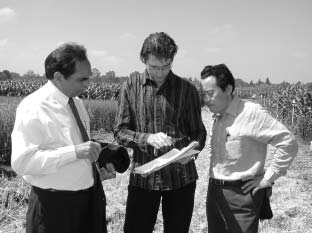How can new knowledge from research on plant DNA quickly reach farmers’ fields in more productive, resource-conserving cultivars? This was only one pressing issue discussed by some 350 crop breeding specialists from over 70 nations, who gathered in Mexico City during 20-25 August for the 2006 International Plant Breeding Symposium.
Co-organized by CIMMYT, Iowa State University, the University of Illinois, Monsanto, and Pioneer Hi-Bred, and supported by numerous sponsors, this year’s event honored John W. Dudley, emeritus professor of plant genetics of the University of Illinois. Dudley is widely recognized for his significant improvements to maize, alfalfa, and sugar beets, his contributions to crop breeding science and allied disciplines, and as a teacher and mentor to leading researchers.
Held in Mexico City’s Sheraton “Centro Histórico” Hotel and involving both public and private sector researchers from developed and developing countries, the program of invited presentations, poster sessions, and other activities fostered partnerships, North- South interactions, and capacity building. Presentation and discussion sessions covered breeding for complex traits, plant breeding education, prebreeding and allelic discovery, quality and nutritional traits, molecular breeding, cultivar development methodologies, and contributions from former students of Dudley.
Field visits to CIMMYT and INIFAP on 23 August ended with a luncheon attended by the Mexican Secretary of Agriculture, Francisco Mayorga Castañeda, and during which the ambassador of India to Mexico, his Excellency R.K. Bhatia, formally presented to Norman E. Borlaug the Padma Vibhushan Award from the Government of India, for his many and illustrious services to farmers of that country. The Padma Vibhushan is India’s second highest civil award and the highest honor India has ever given to a foreign citizen.
Masa Iwanaga, CIMMYT Director General, said the highly successful event was evidence of the vibrant nature of the Center: “The symposium underlines our leadership role in global crop improvement and comes at a fitting moment, as we celebrate 40 years of worldwide research partnerships. Many participants congratulated CIMMYT for demonstrating world-class strength in science and partnerships.”
Masa expressed his gratitude for the work of Petr Kosina and his team, who coordinated symposium logistics; Rodomiro Ortiz, for his efforts on the Program Committee; Kevin Pixley, for organizing the field visit; others who helped with the field tours, and the security and cafeteria staff; Javier Peña, who served as Master of Ceremonies for the field-day luncheon; and John Dodds, for services as Master of Ceremonies for the gala dinner. “There were many, many more who helped make this event something special,” says Masa. “You know who you are, and you have my sincere thanks.”
 Dr Qu Dongyu, Vice-President, CAAS China and Dr M.E. Tusneem, Chairman of the Pakistan Agricultural Research Council, learn about CIMMYT’s conservation agriculture research work from Bram Govaerts during a visit to El Batan this week (see photo below). In addition CIMMYT welcomed visitors from the Ministry of Science and Technology of China and the principal and 16 teachers from the Liceo Mexicano Japonés.
Dr Qu Dongyu, Vice-President, CAAS China and Dr M.E. Tusneem, Chairman of the Pakistan Agricultural Research Council, learn about CIMMYT’s conservation agriculture research work from Bram Govaerts during a visit to El Batan this week (see photo below). In addition CIMMYT welcomed visitors from the Ministry of Science and Technology of China and the principal and 16 teachers from the Liceo Mexicano Japonés.